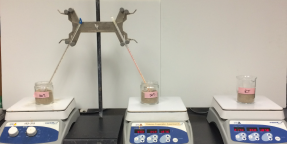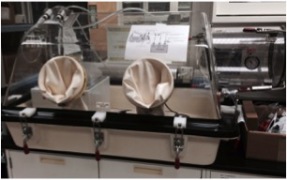Origin of Life
Understanding the emergence of metabolism on early Earth is key to unraveling the factors that promoted the origin of life. Geological components such as metals and minerals may have promoted organic reactions at the emergence of metabolism, for example in gradient-rich hydrothermal vent systems, sediments, and plumes. Prebiotic chemistry could also have occurred on other worlds and could have led to organic signatures that might be detectable by future missions. In this topic area we are investigating how minerals can promote organic and prebiotic chemistry - both to understand origin of life on Earth and to interpret organic signatures we may find elsewhere.
Current funded projects in this topic area include:
Testing the origin of the proton motive force
Foundation award; PI: Laurie Barge (JPL), Karthish Manthiram (Caltech); Collaborators: Jessica Weber (JPL), John-Paul Jones (JPL), Doug LaRowe (USC), Aaron Goldman (Oberlin)
One of the main unsolved questions in the origin of life is how metabolism (life’s ability to generate energy) emerged from a geological setting. In particular, the electron transport chain – where electrons are transferred through a series of enzymes to generate a proton gradient across the cell membrane – is a ubiquitous feature of life today and versions of these pathways were likely also present at the origin of life. In this project we focus on laboratory simulations of specific aspects of electron transport chains in prebiotic settings to test theories relevant to the origin of metabolism.
Simulating the Emergence of Metabolism in an Alkaline Hydrothermal Vent
NASA Exobiology program; PI: Laurie Barge (JPL); Co-I: John-Paul Jones (JPL), Collaborator: Pete Girguis (Harvard)
This project is to conduct laboratory tests of prebiotic reactions that may have driven the emergence of life on Earth at an underwater alkaline hydrothermal vent. Specifically, we will investigate CO2 reduction and CH4 oxidation in a high pressure flow through hydrothermal reactor. The goal of this project is to constrain environments that could have facilitated the origin of life on Earth, which can also be used to inform ocean world astrobiology missions that hypothesize an origin of life on ocean worlds such as Enceladus. There will also be student projects associated with this work regarding hydrothermal precipitation of molybdenum sulfides, and organic reduction on lab synthesized metal hydroxide minerals.
Assessing Origin of Life Scenarios for Exoplanet Studies
JPL Strategic Research & Technology Development; PI: Tiffany Kataria (JPL); Co-I's: Laurie Barge (JPL), Yuk Yung (Caltech), Pin Chen (JPL)
This project investigates the phase space over which terrestrial extrasolar planets may be able to support an origin of life. While biosignatures are commonly used as an indicator of habitable conditions on exoplanets, the possibility of life on another world would also require that world to have been amenable to origin of life conditions. Given what is known about origin of life on Earth, we hypothesize that geological and mineralogical conditions were important drivers for organic reactions: for example, mineral catalyzed carbon reduction or prebiotic organic synthesis. In this project, we will link planetary scale geochemical models with laboratory experiments in prebiotic chemistry, to understand which geologically-driven origin of life reactions are most likely to be impacted by planetary conditions (and thus, might be investigated by future missions).
Phosphorus Redox Chemistry on Rocky and Icy Planets
NASA Habitable Worlds program; PI: Laurie Barge, Co-I: Matt Pasek (University of South Florida)
Phosphorus is an essential element for life, and likely for life's origin, but it is also a limiting element for biochemistry (and prebiotic) reactions. Phosphite (the reduced form) and phosphate (the oxidized form) can both be present in geochemical settings in an early Earth / Mars / ocean worlds context. As part of this project, we are studying how P species can undergo redox reactions in early Earth conditions, and whether P species can phosphorylate organic molecules to feed into astrobiology-relevant reactions that we might be able to detect with future missions.
Archived projects (meaning that the funding period is ended; however, these remain areas of interest for the research group and are possibilities for students who have their own fellowships or funding):
Becoming Biotic: Recapitulating Ancient Cofactor-Mediated Pathways on the Early Earth
NASA-NSF Ideas Lab for the Origins of Life, PI: Laurie Barge, Co-I's: Aaron Goldman (Oberlin), Doug LaRowe (USC)
This project investigates whether we can reconstruct functioning metabolic pathways by replacing protein enzymes with non-protein catalysts in early Earth conditions. Using predictions of ancient metabolic pathways that use different types of cofactors, we are testing the ability of free cofactors to catalyze metabolic reactions without their accompanying proteins in the laboratory. Our first lab studies have focused on reactions relevant to the rTCA cycle (representing potentially ancient metabolic pathways) particularly the reactivity of the metabolic intermediate oxaloacetate; and the cofactors NAD+/NADH, quinones, and iron sulfur clusters. The ultimate goal is to develop a roadmap for future exploration of cofactor-, ribozyme-, and peptide-mediated metabolic pathways under a broad set of environmental conditons relevant to the early Earth.
New Materials Science Technologies for Testing Origin of Life on Ocean Worlds
JPL Researchers on Campus (JROC) program, PI: Laurie Barge, Co-I's: Katherine Faber, Julia Kornfield, Yuk Yung (Caltech)
In this project we will explore new laboratory methods for conducting early Earth and ocean world experiments to simulate the origin of life in hydrothermal vents. A technology limitation so far for these experiments has been the need to control fluid flow in a 3D porous structure that can simulate a hydrothermal chimney, and conduct experiments under realistic vent pressures & temperatures. In this work we will utilize materials science methods to create porous catalytic structures that can simulate prebiotic hydrothermal chimney pores.



